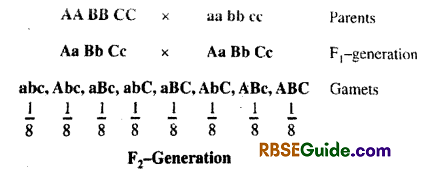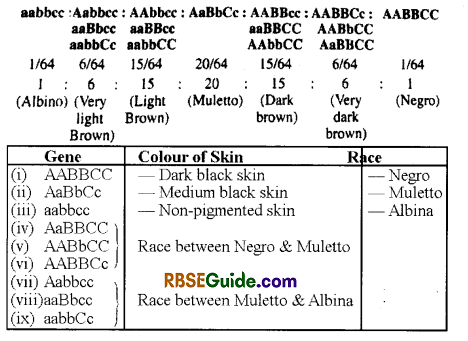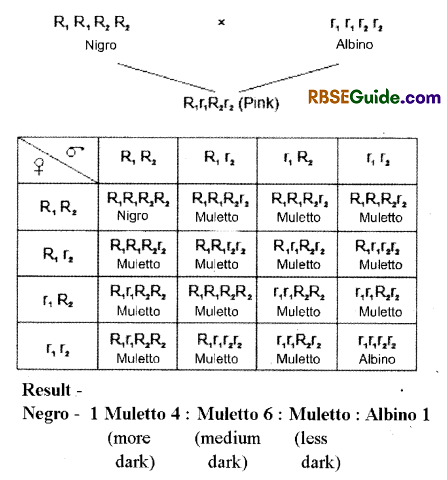Rajasthan Board RBSE Class 12 Biology Notes Chapter 35 Mendel’s Law of Inheritance
General
The phrase “Like begets like” is a universal truth. It simply means that there is a continuify of life and a set of characters in the form of genes is passed on from one generation to another. It is called as heredity or inheritance.
The study of inheritance from one generation to another generation is called as “Genetics”. Thus, the genetics is a science of heredity & variations.
The term genetics was coined by Bateson (1905). The terms gene & allele were coined by Johanson (1909). The alternate forms of gene are called as alleles or allelomorphs.
Sutton was the first to stated that the genes are found on the chrormosomes The genes are arranged in a linear manner on the chromosomes and are transmitted in the form of the chromosomes from generation to generation. Hence, the chromosomes are called as carrier of genetic material. Each gamete has haploid number of chromosomes i.e. half than the parent cell.
The fertilization results in the formation of diploid zygote. The chromosomes behave according to the laws of heredity given by Mendel. The number of chromosomes is limited in the animals but the number of genes is enormous. “Physical basis of heredity”, thus helps to understand the fundamental laws of genetics more adequately.
![]()
Genetics
Science of Genetics started in year 1900 when Mendel’s laws were rediscovered. The word “Genetics was first of all used by William Bateson in 1905. It is a greek word, means to become or to grow. We study Heredity / Inheritance and variations under genetics.
The word “heredity” means those characters or traits which are passed on from one generation to next generation i.e. from parents to offsprings. These variations are inherited from mother & father (parents).
Genetic variations in animals are cuased by sexual reproduction & mutations. They are inherited in the offspring from mother and father. Similarly, environmental variations are those which occurs due to environment, means these variations are not transferred by parents.
Establishment of hereditary initiated by Mendel’s work. Mendel’s work was credited after 35 years of his work by the three scientists who rediscovered and re-established Mendel’s work in the form of Mendel’s laws. This chapter deals with the study of life and work of Mendel. Looking into his contribution, Mendel is known as Father of Genetics.
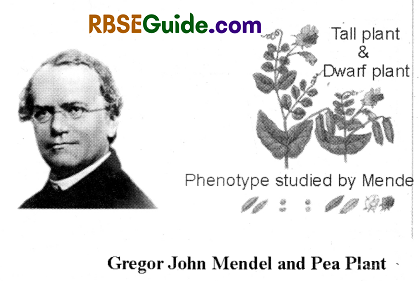
Gregor John Mendel
About Mendel
Gregor Johann Mendel (1822 to 1884) was first to explain the mechanism of transmission of, characters from generation to generation. He is, therefore, called as “father of genetics”. He was bom on July 22, 1822 in a gardner’s family of Austria. In October 1843, he joined Augustinian monastery at Brunn (Austria) as a priest or monk (a religious man). Later in 1851, he joined LIniversity of Vienna to study natural sciences & mathematics & after two years he returned to monastery (Brunn) as a science teacher. He continued for next 14 years as a teacher of natural history & physics.
During the tenure of 1856 to 1864, he performed his historic experiments with garden pea (Pisum sativum) in the monastery garden. He published the results of the classical experiments in a journal “The Annual Proceedings of the Natural History Society of Brunn” in 1906. Unfortunately, the Mendel’s discovery was not appreciated by contemporary biologists. Mendel died in 1884 without knowing that he had laid the foundation of modem genetics.
Lateron, in 1900 his results were rediscovered by three different scientists from three different comers of Europe. These were H. De Vries from Holland, E.V. Tschermak from Austria & K. Correns from Germany. H.De Vries (1901) republished Mendel’s work in Flora. After few years, W. Bateson & others explained that Mendel’s laws can be applied to animals also.
In 1865, he first reported the results of some of his experiments on 30,000 pea plants and published in 1866, a research paper entitled “Experiments in Plant Hybridization” in the annual magazine of Natural History Society of Brunn. His original research paper was published in German language entitled “Versucheuber Pflanzenhybriden”.
![]()
Laws of heredity were formulated on the basis of results of Mendel’s experiment which are called as Mendelism.
Selection of Garden Pea by Mendel for his experiments
Mendel carried out his work on garden pea Pisum sativum. He selected this plant because of following reasons:
- It was easy to grow’ the plants in open ground and in pots.
- The plant had short life span and it completes in one season so study of many generations is possible in few years.
- The pea plant is small, easy to cross breed artificially.
- The plant flower being bisexual, and exhibits self fertilization in nature so that purity of characters can be maintained till many generation but can be easily cross-pollinated experimentally.
- A large number of true breeding varieties of peas are available or we can say ‘many contrasting characters are found in pea plants.
Selection of Characters by Mendel
Mendel conducted breeding experiment on the garden pea plant, Pisum sativum. He studied the inheritance of seven pairs of contrasting characters in the garden pea & he restricted his experiments to one or two pairs of contrasting traits in each experiment. The seven pairs of contrasting characters selected by Mendel are as follows
| S.No. | Character | Recessive | Dominant |
| 1. | Height of Plant | Dwarf | Tall |
| 2. | Position of Flower | Terminal | Axillary |
| 3. | Shape of Pod | Constricted | Inflated |
| 4. | Colour of Pod | Yellow | Green |
| 5. | Shape of seed | Wrinkled | Round |
| 6. | Colour of Seed Coat | White | Grey |
| 7. | Colour of Cotyledon | Green | Yellow |
Some authors follow the colour of flowers-White and Purple character as 7th character instead of colour of cotyledons.
Mendel found all the above 7 traits to be pure genetically in experiments.
Hybrid Techniques of Mendel
All the experiments of Mendel were carefully planned. The technique followed for his experiments to cross plants is as follows
1. Pea is a plant of Self Pollination, because the structure of flower is such that the pollen of the flower fall on the stigma of same flower and there is self pollination. When required to prevent self pollination than Mendel open the flower bud and remove stamen of the flower before they mature. This process is called Emasculation.
2. Mendel put pollen of another flower on the castrated flower’s stigma, which is required to cross for the experiment.
3. To prevent artificially fertilized flowers from insects or from pollination by other flowers, he covered the flowers with suitable bags.
4. The seeds of above experimental plants grown by Mendel and various contrasting characters such as stem, flower, pod and seeds were studied.
5. The experimental plants are termed as parental generation (P), aitd the offspring obtain, from parents are first filial generation (F1 generation). For second hybrid generation Mendel allowed self pollination in the flowers of F1 generation. The resulting seeds when grow gave the second filial generation which is marked as F2 generation.
6. Mendel count the plants having contrasting characters and he did experiments on huge number of plants and observe carefully and noted with shape, size and colour of seed, pods etc. He also mentioned theoretical explanations for the observed numerical figures of each contrasting characters. Theoretical explanation of experiments are known as “Mendel’s laws of inheritance”.
7. Mendel used ‘factor’ word in his experimental character, which is now termed gene.
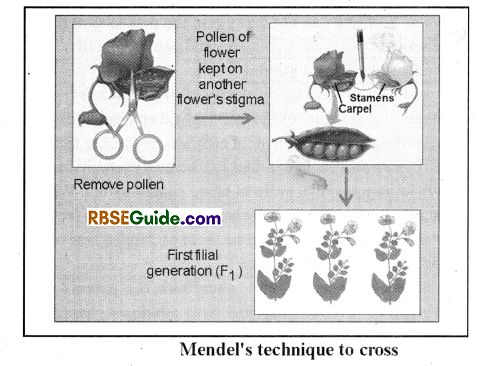
![]()
Mendel’s Breeding Experiments
Mendel did following experiments to cross plants using one or more contrasting characters at one time:
- Monohybrid cross
- Dihybrid cross
- Polyhybrid corss
Monohybrid cross
In this cross, he used one contrasting character at a time. Experiment
He made cross between pure tall and pure dwarf plants:
- Tall plant: Height 6 feet
- Dwarf plant: Height 1 feet
Mendel used plants of F1 generation for self pollination and seeds obtained were sowed. The resulting plants of second filial (F2) generation were both tall and dwarf, in 3:1 ratio. This 3 : 1 ratios is called monohybrid phenotypic ratio. Out of these of dwarf plants were self pollinated and their seeds again gave all dwarf plants. While the tall plants were self pollinated and the seeds obtained were sowed they gave both tall and dwarf plants in the 3 : 1 ratio, phenotypically. The genotype of these plants was found to be 1 : 2 : 1 (1TT; 2Tt : 1tt).
The result shows that tall plants homozygous TT and heterozygous Tt while dwarf plants were tt homozygous.
Mendel’s Explaination
Hence monohybrid cross produce phenotype ratio 3 : 1 and genotype ratio 1 : 2 : 1 in the F2 generation. The logical conclusion arrived at by Mendel from these points was that Fx plants must have carried a ‘hidden factor for dwarfness.

The second conclusion arrived at by Mendel was that if the Fj plants contain two ‘factors’ for height (one responsible for tallness which showed up and one for dwarfhess which remain hidden). Hence pure breed of tall plant contain two factors (TT) for tallness and dwarf plant contain two factors (tt) for dwarfness.
These factors are presently referred as gene. Out of them one factor from father and another factor from mother came into the offspring. The factor which express its character is termed Dominant and which could not express in presence of dominant factor is called Recessive factor.
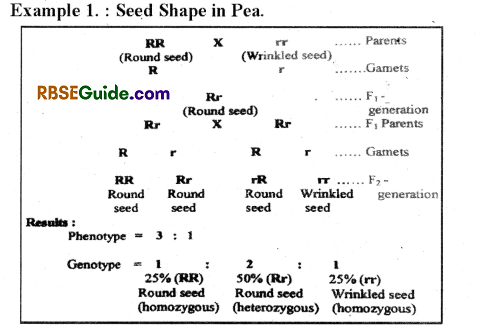
![]()
Dihybrid cross:
In this experiment, Mendel selected two pairs of contrasting characters i.e. Mendel studied inheritance of two characters at a time. He crossed pea plant with round & yellow seeds (RRYY) with plant having wrinkled & green seeds (rryy). In F1 generation, all pea plants produce round & yellow seeds (Rr Yy), which indicates that round is dominant over wrinkled shape and yellow is dominant over green colour. In F2 generation (resulting by self pollination of F1 plants), all the four characters were assorted out independent to each other which indicates that seed colour is independent of seed shape.
The F1 hybrids form 4 types of garnets viz. RY, Ry, rY & ry They on random mating produced & types of generation having phenotypic ratio of 9:3:3:1.
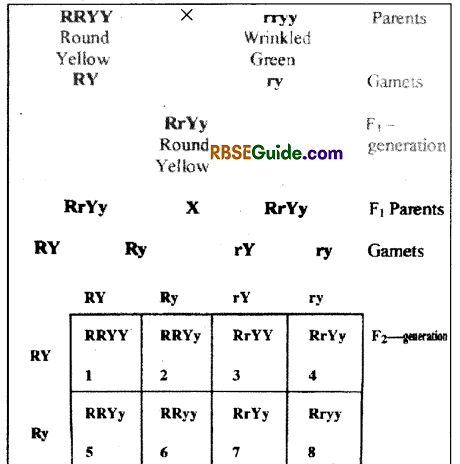
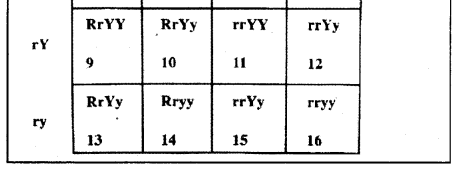
Result of F2 generation
(i) yellow Round => 9 (1, 2, 3, 4, 5, 7, 9, 10, 13)
(ii) yellow Wrinkled => 3(11, 12, 15)
(iii) Green Round => 3 (6, 8, 14)
(iv) Wrinkled green => 1(16)
Mendel’s laws of inheritance
On the basis of his experiments mendel formulated three laws which are popularly called as Mendel’s laws of inheritance. They are as follows:
A. Law of dominance-recessiveness
B. Law of segregation
C. Law of independent assortment
Laws of dominance-recessiveness
Mendel crossed a true breeding tall plant with a true breeding dwarf plant, the progeny became all tall in F1 generation as explained in monohybrid cross.
Traits for tallness of plant is dominant and traits for dwarfness of plant is recessive. This is an example of complete dominance. This law of dominance is most significant for living beings. For example in man, diabetes, colourblindness disease is because of recessive genes. So these can not express in the presence of their dominant allele and will be normal phenotypically.
Law of Segregation
It is also called as Law of purity of gametes. It is based on the F2 generation of the monohybrid cross of Mendel. According to it, when a pair of contrasting genes or factors of alleles are brought together in a hererozygote (hybrid), both remain together without being contaminated. When gametes are formed from the heterozygote, the two factors or genes of alleles separate out from each other and only one enters into each gamete.
It has been observed that when both the parents are hybrids, 75% of the offsprings have dominant character.
For example, in Mendel’s monohybrid cross between tall homozygous (TT) & dwarf homozygous (tt) pea plants; the resulting F1 generation is hybrid (Tt). In F1 hybrid, the tall & dwarf characters appear to have become contaminated and only tall character is expressed. However, at the time of gamete formation, the genes for tallness (T) & for dwarfness (t) separate & are passed into separate gametes. Hence, two types of gametes are produced in equal number i.e. gametes with gene T and with gene t are equal.
F2 – result :
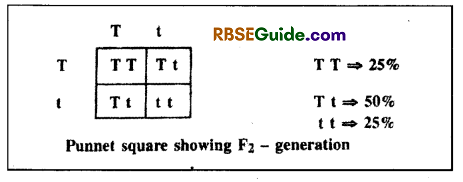
Mendel’s Laws of Inheritance
On the basis of his experiments, Mendel formulated three Significance of Law of Segregation :
- This law proves gene theory.
- Gene is a unit of heredity, which flow traits from one generation to other generation.
- In living beings each character is controlled by a gene.
- Each gene has its two alleles which control one pair of contrasting characters.
- Alleles of gene live together but never mix with each other.
- Both alleles separate at the time of gametogenesis and enter separately into different gametes.
![]()
Law of Independent Assortment
This law is applicable for dihybrid cross or even higher cross. It is not applicable for monohybrid cross.
It states that the factors or genes controlling different characters assort independently without influencing each other during the formation of gametes and get randomly rearranged in the offsprings. It is called law of Independent Assortment. The detail as explained above with Dihybrid cross.
Mendel made a cross between a pea plant with round and yellow seed and pea plants with wrinkled and green seeds (yyrr).
In F1 generation, all plants had yellow and round seeds, because yellow colour is dominant over green and round texture is dominant over wrinkled.
F1 plants were crossed among themselves where all parents showing phenotype Yellow and Round
F2 generation plants were of four types :
- Yellow and Round – Like grand parents. 9/16
- Green and Round – New combination. 3/16
- Yellow and Wrinkled – New combination. 3/16
- Green and Wrinkled – Like grand parents. 1/16
The relative proportion of the types produced are 9 : 3 : 3 : 1 respectively. Genotypic ratio of F2 generation is 1 : 2 : 2 : 4 : 1 : 2 : 1 : 2 : 1.
These characters assorted independently without influencing each other. Hence, it is called as law of independent assortment.
Significance of Mendel’s Law
Mendel with his experiments discarded all the theories given by earlier scientists, as these theories were hypothetical and were not based on scientific experiments.
Initially mendel’s work was also not recognized by other scientists. But it was accepted after 34 years of death of mendel, when three scientists Hugo de Vries, Karl correns and Eric Von Tschermak obtained same results as of Mendel.
Mendel is known as “Father of Genetics” for his valuable contribution in the area of heredity. Achievements of Mendel’s work are mentioned below :
- Scientist discovered dominant and recessive characters in living beings on the basis of Mendel’s work.
- Beneficial characters of different generaare brought together in a genus.
- By using Mendel’s law, discovery of immunity against diseases, continuity in adverse conditions, flowers and fruits of good quality and in quantity are developed.
- Similarly Breed of Cow, buffalo and hen are improved.
Reasons of Mendel’s Success
The various reasons of the Success of Mendel’s experiment are as follows :
- Mendel studied the inheritance of one character at a time.
- He carried out experiments up’to F2 & F3 generations.
- Mendel maintained the statistical record of all the experiments.
- He selected the experimental material carefully. He selected pure breed of the parent plants and the purity was tested by self crossing the progeny for several generations.
- He crossed plant parents of pure lines having sharply visible contrasting characters.
Back cross and Test cross
Back Cross 1
“Across between a Fj offspring and one of its parents”.
Animal or plant obtained through monohybrid cross is crossed with one of its parent, then it is called Back cross.
Test Cross
A cross between the unknown genotype with the homozygous recessive organisms of the same trait is called Test cross.
It is used to ascertain wheather a dominant phenotype is homozygous or heterozygous.
Various Terminologies
Mendel used various terminologies in his experiments.
These are as follows :
(i) Factor (Gene)
Factor: Term used by Mendel. Each trait is controlled by a pair of factors. Now it is replaced by the term gene.
Gene : Abasic unit of heredity, located on a chromosome or it is a part of DNA molecule. It decides heredity and epxression of a specific character.
(ii) Phenotype and Genotype
Genotype : Genetic expression of a feature, which obtained from parents. Ex. Pure round seed producing parent plants has genotype R R.
Phenotype: Visible expression of the hereditary character possessed by an organism. For example round or wrinkled shape of seed is its phenotype.
(iii) Homozygous and Heterozygous
There are two genes for every character. If the two genes for a particular character are identical, is said to be homozygous (G homos => same; zygotos => a pair). For example tall plants (TT) & dwarf plant (tt) are homozygous.
| Homozygous | Heterozygous | |
|
|
Formation of only one type of gametes. | Formation of 2 types of gametes. |
|
|
Breed true to the particular character. | Do not breed true to the particular character. |
|
|
It possesses two identical alleles of a gene. | It possesses two contrasting alleles of a gene. |
![]()
(iv) Dominant and Recessive
Dominant character:Amongst two alleles of a character, the character express in a heterozygous condition is called Dominant character. The incidence is known as Dominance and the gene responsible for it is dominant allele.
For Example . Tt containing pea plant has T for tallness and t for dwarfness and T is the dominant character.
Recessive character: Amongst Alleles of a character in F1 generation, which is not expressed is called recessive character. It expresses only in homozygous condition of character e.g. 11 condition express dwarfness of plant.
(v) Parental generation: Father and mother act as a parental generation (P1) for cross of an experiment.
(vi) F1 generation : The offsprings of two parents (father and mother P1) are known as first filial genration (F1).
(vii) F2 generation: Self pollination in F1 generation produce Second filial generation (F2).
(viii) Alleles: Alternative forms of a gene for eg. blue colour and black colour of the eye are two alleles of the colour of eye gene. Allele is a short form of Allelomorph. Similarly, for the seed of pea plant, the shape of the seed Round (R) and Wrinkled (r) are two alleles.
(ix) Monohybrid and Dihybrid cross
Monohybrid cross : Across in which inheritance of only one pair of contrasting character is studied.
Dihybrid cross : A cross in which inheritance of two pairs of contrasting characters are studied simultaneously.
(x) Reciprocal cross:
A cross where gametes from parental generation are reversed. For example if first cross father is dwarf and mother is tall then in reciprocal cross father will be Tall and mother will be dwarf.
Deviation of Mendel’s Laws
Incomplete Dominance
- It was discovered by correns (1903).
- It is also called as blended or partial or mosaic or intermediate inheritance.
- It is an exception to be outcome of mendeTs monohybrid cross.
- It is found in both plants & animals.
- In mendel’s pea experiments, dominance was essentially complete & there was no difference between the homozygous & heterozygous plants in the expression of dominant character. However, there are characters or alleles that are neither dominant nor recessive. In such cases, both the alleles of the contrasting conditions of a character express as a blend.
- As a result, in Fx generation the hybrid produced by crossing two pure individiuals does not resemble either of them, but is midway between them. This expression of intermediate trait of two pure parents in the F1 hybrids is called as incomplete dominance.
- Example 1 : Four O’clock plant (Mirabilis jalapa) & snapdragon plant (Antirrhimum majus)
Incomplete dominance in Snapdragon
Here the phenotypic and genotypic ratios are same. The ratio 1 : 2 : 1 is characterstics of Incomplete Dominance.
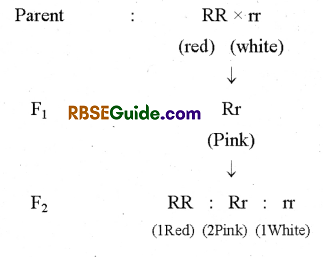
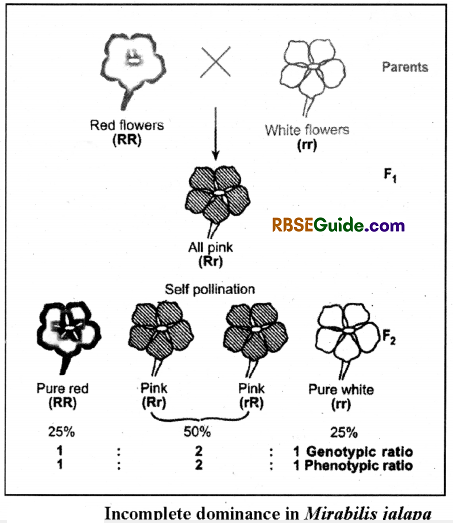
![]()
Co-Dominance
Dominant and recessive factor of an allele equally express their characters in F1 generation is called co-dominance. The skin colour in cattles is red (RR) and white (rr) is found. The cross of these gives roan colour of skin in F1 generation. Then cross between F1generation gives red, roan and white skin cattles in F2 generation. The ratio of red, roan and white coloured skin animals is found 1 : 2 : 1 (RR : Rr : rr). The results does not follow Mendelian ratio with regard to colours.
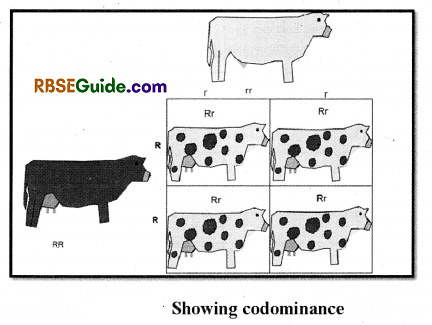
Difference between co-dominance and incomplete dominance:
| S.No. | Co-dominance | Incomplete dominance |
| 1. | The heterozygous shows ratio of both alleles in Fi generation. For ex. blood group AB has both the antigens xA as well as B. | The heterozygous is of the intermediate type and shows none of the original parental
forms eg. Pink colour flower of snapdragn. |
| 2. | Both alleles are equally dominant. Both express fully and equally | There is partial dominance of one and hence intermediate type is formed. |
| 3. | Examples: ABO blood group and skin colour of cattle. | Examples: Colour of snapdragon flowers and flowers of Four O’ clock plant. |
Multiple alleles
Normally phenotypic expression is controlled by a pair of alleles. For example Tall and dwarf; Red and white; Brown eyes and blue eyes etc.
Sometimes three or more alleles are responsible for a single character. It is called Multiple alleles.
All these alleles are found at specific locus on the chromosome.
The best example of multiple alleles is A B O blood group system of human beings.
Four blood groups under .ABO system are decided by three alleles namely IA. IB and, IO. The alleles IA and IB are dominant and Io or i is recessive. Allele IO is recessive and does not produce any antigen. Out of these three only two alleles are found at a time in human being. Genotype and phenotype of human blood groups are given in the following table :
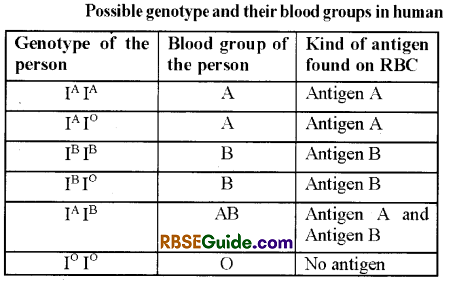
Lethal genes
Some genes besides controlling external charactersitcs they also affect viability of organisms.
L. Cuenot in 1905 presented results of his experiment on the body colour of rats. These results were different from the Mendel’s law of segregation.
According to his experiments yellow colour of skin is due to gene Y and grey colour is due to gene y in which Y is dominant over y (grey colour). When yellow colour rats were crossed then yellow and grey colour rats in 2 : 1 ratio produced. Genotypically, yellow rats were heterozygous (Yy) and grey rats were homozygous (yy). The Yy (heterozyougs) yellow colour rats were unable to survive. Hence Y gene is responsible for yellow colour of rats and it also affect surv ival capacity. The yellow homozygous (YY) rats can not survive, hence homozygous rats are not found at all.
Hence AW genes are called lethal genes and this incidence is known as Lethality. Some lethal genes are lethal only in homozgyous recessive condition and called as recessive lethal gene, while dominant lethal gene may be lethal even in heterozygous condition.
Pleiotropy
The ability of a gene to have multiple effects is called pleiotropy. Such genes are termed as pleiotropic genes.
The pleiotropic genes may not have equal influence on all the traits they control.
Example 1. : The genes that control colour of flowers in sweet pea also control the colour of the seed coats and red spots in the axial of leaves.
Example 2 : In Drosophila, the genes controlling size of the wings also control the nature of balancers, colour of the eyes, fertility & longevity.
Example 3 : In human beings, sickle cell anaemia is a good example of pleiotropy. The genes causing this disease also alter the shape of RBC & the type of haemoglobin.
The RBC become sickle shaped. Such RBC’s carry low amount of oxygen and leading to anaemia. This in turn may lead to heart and kidney failure. The homozygous recessive individual dies early in life due to severe anaemia caused by premature destruction of RBC’s.
While heterozygous individuals survive but show mild anaemia, these have both normal and abnormal haemoglobin and he*nce some cells are sickle shaped. Such heterozygous individuals are highly resistant to malaria, because malarial parasite can not live in these abnormal cells. Malarial parasite survives in normal blood cells and so affects the normal homozygous individuals.
A cross between heterozygous male and heterozygous female results in one-fourth of offpsings as normal. Half as carriers and remaining one-fourth as homozygous recessive (the homozygous recessive do not survive and die early in life). So we get an unusual ratio of 1 normal : 2 carriers. The unusual ratio of living offsprings helps to identify the presence of a lethal gene.
![]()
Polygenes
The phenotype traits which are governed by three or more genes are called as polygenic traits. The polygenic traits show a wide range of phenotypes. Each gene of the polygenic trait contribute to the phenotype but to a small degree.
Presence of more than one dominant gene makes the phenotype more prominant. All the dominant genes add up their effects to produce a full phenotype. Therefore, the polygenic traits are also called as quantitative traits.
Inheritance of such traits is called as polygeneic or quantitative inheritance.
The polygenes may occupy two or more different loci on the same homologous chromosome pair.
It was first studied by Galton (1883) in man.
The well known examples of polygenic trait are human
skin colour & kernel colour in wheat.
The other examples of polvgenic traits in human beings are – eye colour & body height.

